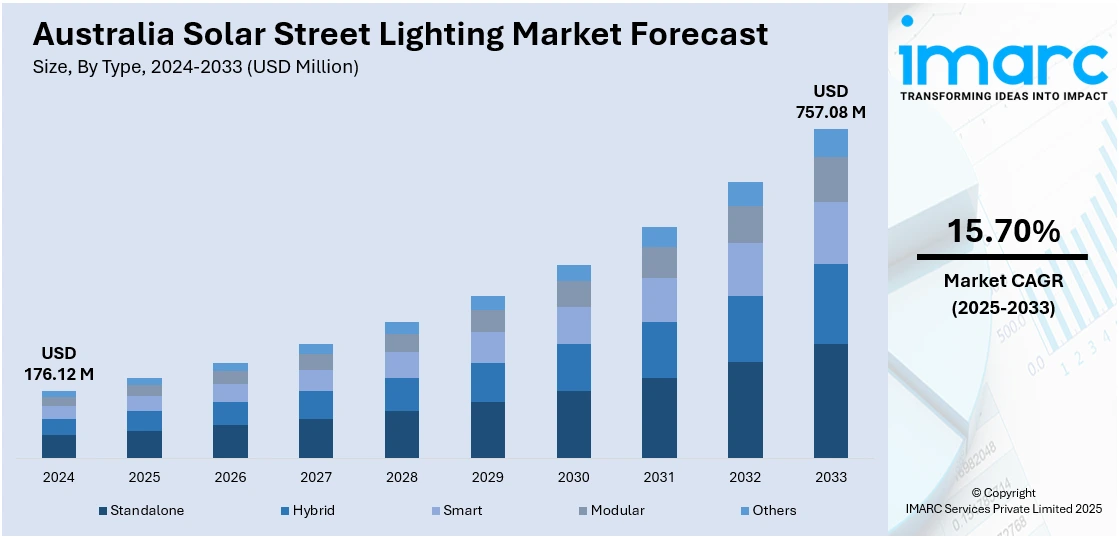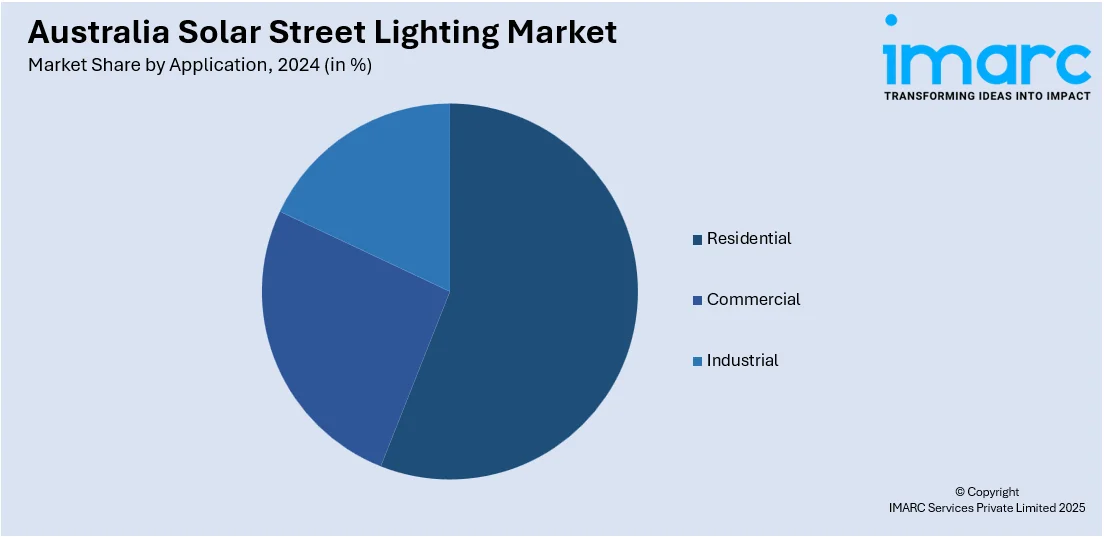
Australia Solar Street Lighting Market Size, Share, Trends and Forecast by Type, Application, and Region, 2025-2033
Australia Solar Street Lighting Market Overview:
The Australia solar street lighting market size reached USD 176.12 Million in 2024. Looking forward, IMARC Group expects the market to reach USD 757.08 Million by 2033, exhibiting a growth rate (CAGR) of 15.70% during 2025-2033. Australia is witnessing rapid growth in the solar street lighting sector, driven by technological innovations such as the integration of smart technologies, the expansion of infrastructure in remote communities, and the implementation of supportive government policies. Such innovations provide greater energy efficiency, lower costs, and support sustainability initiatives. With growing uptake in urban and rural areas, the Australia solar street lighting market share increases which is a key move toward more environmentally friendly, more sustainable infrastructure.
|
Report Attribute
|
Key Statistics
|
|---|---|
|
Base Year
|
2024
|
|
Forecast Years
|
2025-2033
|
|
Historical Years
|
2019-2024
|
| Market Size in 2024 | USD 176.12 Million |
| Market Forecast in 2033 | USD 757.08 Million |
| Market Growth Rate 2025-2033 | 15.70% |
Australia Solar Street Lighting Market Trends:
Smart Technology Integration in Solar Street Lighting
Smart technology integration in solar street lighting is emerging as a major trend in Australia. With cities and regions throughout the country increasingly looking to energy-efficient solutions, smart solar streetlights provide advanced features like motion sensing, remote monitoring, and automated dimming. For instance, in 2024, the solar lighting market undergoes revolutionary innovations, such as high-efficiency solar panels (gallium arsenide, perovskite), intelligent controls, adaptive illumination, and environmentally friendly materials. All these advances have the promise of enhanced energy efficiency, sustainability, and economy. Moreover, these developments enable greater dynamism and efficiency in the utilization of solar-powered illumination, cutting back on energy usage while ensuring maximum lighting. Through remote monitoring of the performance of every streetlight, predictive maintenance is facilitated, which guarantees lights are in working condition and offering protection in real time. Also, smart technology can be made compatible with other smart city infrastructure, enhancing the management of cities at large. This trend will further pick up speed due to increasing needs for energy-efficient, green, and intelligent urban spaces. Solar streetlights will find their place as central actors in smart cities of the future.

To get more information on this market, Request Sample
Increase of Solar Street Lighting in Remote Places
With increasing sustainable energy solutions, the Australia solar street lighting market growth in off-grid and remote regions is witnessing substantial momentum. With the difficulty of offering cheap and reliable street lighting to such areas, an upscale demand for solar-powered solutions has emerged. Solar streetlights are a perfect choice for off-grid locations because they are self-sufficient and will remain functional even in regions with very limited availability of electricity infrastructure. This applies particularly to regional and rural communities that might otherwise be challenged by high electricity bills and unreliable power supply. The increase in solar street lighting in such regions is not only improving security and safety but also playing its part in driving Australia's campaign for the uptake of renewable energy in remote communities. As per the reports, between 2024 and 2025, Australia's solar street lighting industry will develop through innovations from businesses such as Sresky, with a view to remote fault diagnosis, real-time energy optimization, and modular designs to achieve greater efficiency and sustainability. Furthermore, the trend represents a breakthrough in taking solar technology to other parts of the country.
Government Policy and Support for Solar Street Lighting
Government incentives and programs facilitating solar street lighting adoption are key factors in the expansion of the solar street lighting business in Australia. As the need for sustainability and renewable energy rises, governments of states and regions have made offerings of incentives, funding, and legislation designed to promote the addition of solar streetlights. Their purpose is lowering carbon emissions as well as making electricity less costly for cities and towns. Government-initiated initiatives tend to prioritize the development of urban infrastructure through the integration of energy-saving technologies, including solar street lighting, in public areas. The increasing priority on decreasing dependency on non-renewable energy sources has also spurred the use of solar light solutions in public areas, becoming an integral part of Australia's overall sustainability strategy. As governments increasingly place emphasis on green projects, solar street lighting will continue to experience growth, cementing its position in Australia's energy future further.
Australia Solar Street Lighting Market Segmentation:
IMARC Group provides an analysis of the key trends in each segment of the market, along with forecasts at the country and regional levels for 2025-2033. Our report has categorized the market based on type and application.
Type Insights:
- Standalone
- Hybrid
- Smart
- Modular
- Others
The report has provided a detailed breakup and analysis of the market based on the type. This includes standalone, hybrid, smart, modular, and others.
Application Insights:

- Residential
- Commercial
- Industrial
A detailed breakup and analysis of the market based on the application have also been provided in the report. This includes residential, commercial, and industrial.
Regional Insights:
- Australia Capital Territory & New South Wales
- Victoria & Tasmania
- Queensland
- Northern Territory & Southern Australia
- Western Australia
The report has also provided a comprehensive analysis of all the major regional markets, which include Australia Capital Territory & New South Wales, Victoria & Tasmania, Queensland, Northern Territory & Southern Australia, and Western Australia.
Competitive Landscape:
The market research report has also provided a comprehensive analysis of the competitive landscape. Competitive analysis such as market structure, key player positioning, top winning strategies, competitive dashboard, and company evaluation quadrant has been covered in the report. Also, detailed profiles of all major companies have been provided.
Australia Solar Street Lighting Market News:
- In April 2024, SolarEdge Technologies and Signify are at the forefront of commercial solar street lighting in Australia. Their solutions are centered around smart technologies, such as motion sensors and dimming features for energy efficiency. Increased battery storage and IoT connectivity for real-time monitoring, along with green designs, are pushing sustainable urban infrastructure.
Australia Solar Street Lighting Market Report Coverage:
| Report Features | Details |
|---|---|
| Base Year of the Analysis | 2024 |
| Historical Period | 2019-2024 |
| Forecast Period | 2025-2033 |
| Units | Million USD |
| Scope of the Report |
Exploration of Historical Trends and Market Outlook, Industry Catalysts and Challenges, Segment-Wise Historical and Future Market Assessment:
|
| Types Covered | Standalone, Hybrid, Smart, Modular, Others |
| Applications Covered | Residential, Commercial, Industrial |
| Regions Covered | Australia Capital Territory & New South Wales, Victoria & Tasmania, Queensland, Northern Territory & Southern Australia, Western Australia |
| Customization Scope | 10% Free Customization |
| Post-Sale Analyst Support | 10-12 Weeks |
| Delivery Format | PDF and Excel through Email (We can also provide the editable version of the report in PPT/Word format on special request) |
Key Questions Answered in This Report:
- How has the Australia solar street lighting market performed so far and how will it perform in the coming years?
- What is the breakup of the Australia solar street lighting market on the basis of type?
- What is the breakup of the Australia solar street lighting market on the basis of application?
- What is the breakup of the Australia solar street lighting market on the basis of region?
- What are the various stages in the value chain of the Australia solar street lighting market?
- What are the key driving factors and challenges in the Australia solar street lighting?
- What is the structure of the Australia solar street lighting market and who are the key players?
- What is the degree of competition in the Australia solar street lighting market?
Key Benefits for Stakeholders:
- IMARC’s industry report offers a comprehensive quantitative analysis of various market segments, historical and current market trends, market forecasts, and dynamics of the Australia solar street lighting market from 2019-2033.
- The research report provides the latest information on the market drivers, challenges, and opportunities in the Australia solar street lighting market.
- Porter's five forces analysis assist stakeholders in assessing the impact of new entrants, competitive rivalry, supplier power, buyer power, and the threat of substitution. It helps stakeholders to analyze the level of competition within the Australia solar street lighting industry and its attractiveness.
- Competitive landscape allows stakeholders to understand their competitive environment and provides an insight into the current positions of key players in the market.
Need more help?
- Speak to our experienced analysts for insights on the current market scenarios.
- Include additional segments and countries to customize the report as per your requirement.
- Gain an unparalleled competitive advantage in your domain by understanding how to utilize the report and positively impacting your operations and revenue.
- For further assistance, please connect with our analysts.
 Request Customization
Request Customization
 Speak to an Analyst
Speak to an Analyst
 Request Brochure
Request Brochure
 Inquire Before Buying
Inquire Before Buying




.webp)




.webp)












